Wheelchair
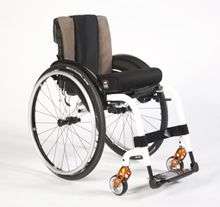
A wheelchair is a chair with wheels. The device comes in variations allowing either manual propulsion by the seated occupant turning the rear wheels by hand, or electric propulsion by motors. There are often handles behind the seat to allow it to be pushed by another person.
Wheelchairs are used by people for whom walking is difficult or impossible due to illness, injury, or disability. People who have difficulty sitting and walking often make use of a wheelbench.
History
The earliest records of wheeled furniture was an inscription found on a stone slate in China and a child’s bed depicted in a frieze on a Greek vase, both dating back to the 5th century BCE.[1][2] The first records of wheeled seats being used for transporting the disabled date to three centuries later in China; the Chinese used their invented wheelbarrow to move people as well as heavy objects. A distinction between the two functions was not made for another several hundred years, around 525 CE, when images of wheeled chairs made specifically to carry people begin to occur in Chinese art.[2]
Later dates relate to Europeans using this technology during the German Renaissance.
The invalid carriage or Bath Chair seems to date from around 1760.[3]
In 1887, wheelchairs ("rolling chairs") were introduced to Atlantic City so invalid tourists could rent them to enjoy the Boardwalk. Soon, many healthy tourists also rented the decorated "rolling chairs" and servants to push them as a show of decadence and treatment they could never experience at home.[4]
Harry Jennings and his disabled friend Herbert Everest, both mechanical engineers, invented the first lightweight, steel, collapsible wheelchair[5] in 1933. Everest had broken his back in a mining accident.
The two saw the business potential of the invention and went on to become the first mass-manufacturers of wheelchairs: Everest and Jennings. Their "x-brace" design is still in common use, albeit with updated materials and other improvements.
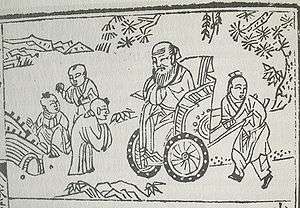
Types
A basic manual wheelchair incorporates a seat, foot rests and four wheels: two, caster wheels at the front and two large wheels at the back. The two larger wheels in the back usually have handrims; two metal or plastic circles approximately 3/4" thick. The handrims have a diameter normally only slightly smaller than the wheels they are attached to. Most wheelchairs have two push handles at the top of the back to allow for manual propulsion by a second person.
Other varieties of wheelchair are often variations on this basic design, but can be highly customised for the user's needs. Such customisations may encompass the seat dimensions, height, seat angle (also called seat dump or squeeze), footrests, leg rests, front caster outriggers, adjustable backrests and controls.
Everyday manual wheelchairs come in two major designs—folding or rigid. The rigid chairs, which are increasingly preferred by active users, have permanently welded joints and many fewer moving parts. This reduces the energy required to push the chair by eliminating many points where the chair would flex as it moves. Welding the joints also reduces the overall weight of the chair. Rigid chairs typically feature instant-release rear wheels and backrests that fold down flat, allowing the user to dismantle the chair quickly for storage in a car.
Many rigid models are now made with ultralight materials such as aircraft aluminium and titanium. One major manufacturer, Tilite, builds only ultralights. Another innovation in rigid chair design is the installation of polymer shock absorbers, such as Frog Legs, which cushion the bumps over which the chair rolls. These shock absorbers may be added to the front wheels or to the rear wheels, or both. Rigid chairs also have the option for their rear wheels to have a camber. Wheels can have a camber, or tilt, which angles the tops of the wheels in toward the chair. This allows for better propulsion by the user which is desired by long-term users. Sport wheelchairs have large camber angles to improve stability.
Various optional accessories are available, such as anti-tip bars or wheels, safety belts, adjustable backrests, tilt and/or recline features, extra support for limbs or neck, mounts or carrying devices for crutches, walkers or oxygen tanks, drink holders, and clothing protectors.
Transport wheelchairs are usually light, folding chairs with four small wheels. These chairs are designed to be pushed by a caregiver to provide mobility for patients outside the home or more common medical settings.
Experiments have also been made with unusual variant wheels, like the omniwheel or the mecanum wheel. These allow for a broader spectrum of movement.

The electric wheelchair shown on the right is fitted with Mecanum wheels (sometimes known as Ilon wheels) which give it complete freedom of movement. It can be driven forwards, backwards, sideways, and diagonally, and also turned round on the spot or turned around while moving, all operated from a simple joystick.
Manually propelled

Manual wheelchairs are those that require human power to move them. Many manual wheelchairs can be folded for storage, or placement into a vehicle, although modern wheelchairs are just as likely to be rigid framed.
Manual or self-propelled wheelchairs are propelled by the occupant, usually by turning the large rear wheels, from 20-24 inches (51–61 cm)in average diameter, and resembling bicycle wheels. The user moves the chair by pushing on the handrims, which are made of circular tubing attached to the outside of the large wheels. The handrims have a diameter that is slightly less than that of the rear wheels. Skilled users can control speed and turning and often learn to balance the chair on its rear wheels — do a wheelie. The wheelie is not just for show — a rider who can control the chair in this manner can climb and descend curbs and move over small obstacles.
Foot propulsion of the wheelchair by the occupant is also common for patients who have limited hand movement capabilities or simply do not wish to use their hands for propulsion. Foot propulsion also allows patients to exercise their legs to increase blood flow and limit further disability.
One-arm drive enables a user to guide and propel a wheelchair from one side. Two handrims, one smaller than the other, are located on one side of the chair, left or right. On most models the outer, or smaller rim, is connected to the opposite wheel by a folding axle. When both handrims are grasped together, the chair may be propelled forward or backward in a straight line. When either handrim is moved independently, the chair will turn left or right in response to the handrim used. Some chairs are also configured to allow the occupant to propel using one or both feet instead of using the rims.
Light weight and high cost are related in the manual wheelchairs market. At the low-cost end, heavy, tubular steel chairs with sling seats and little adaptability dominate. Users may be temporarily disabled, or using such a chair as a loaner, or simply unable to afford better. Heavy unmodified manual chairs are common as "loaners" at large facilities such as airports, amusement parks and shopping centers. In a higher price range, and more commonly used by persons with long-term disabilities, are major manufacturer lightweight chairs with more options. The high end of the market contains ultra-light models, extensive seating options and accessories, all-terrain features, and so forth. Reclining wheelchairs have handbrake-like controls attached to the push handles or posts supporting the backrest which, when pressed by the caregiver, allow the backrest to recline from is normal upright position (at 90 degrees) to varying angles up to 180 degrees.
Transport wheelchairs
Attendant-propelled chairs (or transport wheelchairs) are designed to be propelled by an attendant using the handles, and thus the back wheels are rimless and often smaller. These chairs are often used as 'transfer chairs' to move a patient when a better alternative is unavailable, possibly within a hospital, as a temporary option, or in areas where a user's standard chair is unavailable. These chairs are commonly seen in airports. Special airplane transfer chairs are available on most airlines, designed to fit narrow airplane aisles and transfer wheelchair-using passengers to and from their seats on the plane.
Electric-powered
An electric-powered wheelchair is a wheelchair that is moved via the means of an electric motor and navigational controls which is usually a small joystick mounted on the armrest, rather than manual power. For users who cannot manage a manual joystick, headswitches, chin-operated joysticks, sip-and-puff or other specialist controls may allow independent operation of the wheelchair.
Wheelbase chairs are wheeled platforms with specially molded seating systems interfaced with them for users with a more complicated posture. A molded seating system involves taking a cast of a person's best achievable seated position and then either carving the shape from memory foam or forming a plastic mesh around it. This seat is then covered, framed, and attached to a wheelbase.
Other variants
A dynamic tilt wheelchair has seating surfaces which can be tilted to various angles. It was developed by an orthotist, Hugh Barclay, who worked with disabled children and observed that postural deformities such as scoliosis could be supported or partially corrected by allowing the wheelchair user to relax in a tilted position. Invented in Kingston, Ontario, Canada, in the early 1980s, the dynamic tilt wheelchair type is now manufactured by a number of companies and used all around the world. This revolutionary adaptation of wheelchair design provides individuals with very complex health needs the opportunity for increased mobility.
A Standing wheelchair is one that supports the user in a nearly standing position. They can be used as both a wheelchair and a standing frame, allowing the user to sit or stand in the wheelchair as they wish. They often go from sitting to standing with a hydraulic pump or electric-powered assist. Some options are provided with a manual propel model and power stand, while others have full power, tilt, recline and variations of power stand functions available as a rehabilitative medical device. The benefits of such a device include, but are not limited to: aiding independence and productivity, raising self-esteem and psychological well-being, heightening social status, extending access, relief of pressure, reduction of pressure sores, improved functional reach, improved respiration, reduced occurrence of UTI, improved flexibility, help in maintaining bone mineral density, improved passive range motion, reduction in abnormal muscle tone and spasticity, and skeletal deformities.
A bariatric wheelchair is one designed to support larger weights; most standard chairs are designed to support no more than 250 lb (113 kg) on average.
Pediatric wheelchairs are another available subset of wheelchairs. Hemi wheelchairs have lower seats which are designed for easy foot propulsion. The decreased seat height also allows them to be used by children and shorter individuals.
A knee scooter is a related device which may be substituted for a wheelchair when an injury has occurred to only one leg, below the knee. The patient rests the injured leg on the scooter, grasps the handlebars, and pushes with the uninjured leg.
A power-assisted wheelchair is a recent development that uses the frame & seating of a typical manual chair while replacing the standard rear wheels with wheels that have small battery-powered motors in the hubs. A floating rim design senses the pressure applied by the users push & activates the motors proportionately. This results in the convenience, small size & light-weight of a manual chair while providing motorised assistance for rough/uneven terrain & steep slopes that would otherwise be difficult or impossible to navigate, especially by those with limited upper-body function.
Sports variants

Athletes with a disability use sport wheelchairs for disabled sports that require speed and agility, such as basketball, rugby, tennis, racing and dancing. Each wheelchair sport tends to use specific types of wheelchairs, and these no longer look like their everyday cousins. They are usually non-folding (in order to increase rigidity), with a pronounced negative camber for the wheels (which provides stability during a sharp turn), and made of composite, lightweight materials. Sport wheelchairs are not generally for everyday use, and are often a 'second' chair specifically for sport use, although some users prefer the sport options for everyday.

- Powerchair Football/Power Soccer
A new sport has been developed for powerchair users called powerchair football or power soccer. The Federation Internationale de Powerchair Football Associations (FIPFA)[6] governs the sport and is located in Paris, France with country affiliates around the world.
Transfer, stretcher, or mechanical
Stretcher (or transfer) chairs are mobile chairs that can be adjusted to lie flat like stretchers to help in the lateral (or supine) transfer of a patient from a bed to the chair. Once transferred, the stretcher can be adjusted to allow the patient to assume a sitting position. Transfer chairs often use sliding sheets or inflatable sliding mats with air bearings to facilitate the movement of the patient from the bed to the chair. The patient in bed is rolled onto the transfer sheet or mat, and the sheet slides between the bed and the chair (configured as a flat stretcher), carrying the patient with it. Transfer chairs sometimes have separate manual cranks or electric winches which attach to the sliding sheet and pull (or drag) the patient off the bed and onto the chair. Such devices can also be used to transfer patients to standard gurneys. Alternately, nurses can lift or slide the transfer sheet and patient manually. Transfer chairs are usually much more expensive than common wheelchairs, because of the complex engineering required to be able of change the chair's configuration from a stretcher to a mobile chair. This kind of lateral patient transfer requires a stable platform to prevent injury (i.e., avoid patient falls). This stability requirement makes transfer chairs larger, heavier, and less mobile than standard wheelchairs.
All terrain variants
All-terrain wheelchairs allow users to enter the water and provide a better mobility on beach sand and on uneven terrain, and even snow. The common adaptation among the different designs is that they have extra-wide wheels or tires, to increase stability on uneven or unsteady terrain. The wide tires on snow wheelchairs, for example, spread the weight of the chair user and the chair over a wider surface, similar to how snowshoes perform the same purpose for someone on foot, allowing the person to travel on top of the snow rather than sinking.
Different models are available, both manual and battery-driven. In many countries in Europe, where accessible tourism is well established, many beaches are wheelchair accessible and provide this kind of wheelchair to clients free of charge. Some charge a rental fee.
Recent developments
Recent technological advances are slowly improving wheelchair and EPW technology. Some wheelchairs, such as the iBOT, incorporate gyroscopic technology and other advances, enabling the chair to balance and run on only two of its four wheels on some surfaces, thus raising the user to a height comparable to a standing person. They can also incorporate stair-climbing and four-wheel-drive feature motorized assists for hand-powered chairs are becoming more available and advanced. The popular Segway Personal Transporter is a mobility device that was a direct outgrowth of the development of the iBOT wheelchair. The Segway, which is basically an iBOT with two wheels removed, was developed explicitly to increase the number of units produced and take advantage of the economies of scale to make the iBOT affordable to wheelchair users. The $25,000 iBot, which was developed as a joint venture between Johnson and Johnson's Independence Technology and Dean Kamen's DEKA Research, was discontinued in January 2009.
A variation on the hand-powered wheelchair is the Leveraged Freedom Chair (LFC), designed by the MIT Mobility Lab. This wheelchair is designed to be low-cost, constructed with local materials, for users in developing countries. Engineering modifications have added hand-controlled levers to the LFC, to enable users to move the chair over uneven ground and minor obstacles, such as bumpy dirt roads, that are common in developing countries. It is under development, and has been tested in Kenya and India so far.
The addition of geared, all-mechanical wheels for manual wheelchairs is a new development incorporating a hypocycloidal reduction gear into the wheel design. The 2-gear wheels can be added to a manual wheelchair. The geared wheels provide a user with additional assistance by providing leverage through gearing (like a bicycle, not a motor). The two-gear wheels offer two speed ratios- 1:1 (no help, no extra torque) and 2:1, providing 100% more hill climbing force. The low gear incorporates an automatic "hill hold" function which holds the wheelchair in place on a hill between pushes, but will allow the user to override the hill hold to roll the wheels backwards if needed. The low gear also provides downhill control when descending.
A recent development related to wheelchairs is the handcycle. They come in a variety of forms, from road and track racing models to off-road types modelled after mountain bikes.
There have been significant efforts over the past 20 years to develop stationary wheelchair trainer platforms that could enable wheelchair users to exercise as one would on a treadmill or bicycle trainer.[7][8] Some devices have been created that could be used in conjunction with virtual travel and interactive gaming similar to an omnidirectional treadmill.
In 2011, British inventor Andrew Slorance developed Carbon Black the first wheelchair to be made almost entirely out of carbon fibre[9][10]
Recently, EPFL's CNBI project has succeeded in making wheelchairs that can be controlled by thought transference.[11][12]
-
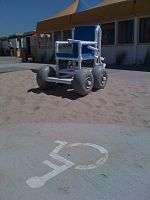
A beach wheelchair at a public beach in the Netherlands
-
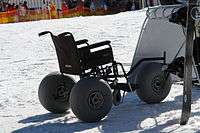
A snow wheelchair at an outdoor park
-
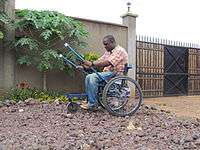
A Leveraged Freedom Chair wheelchair user in Kenya. The chair has been engineered to be low-cost and usable on the rough roads common in developing countries.
Mobility and access
 Wheelchair ramp and disabled parking space  A gate for wheelchairs in Hiroshima 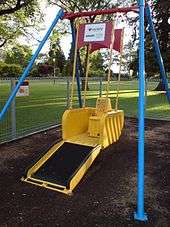 A wheelchair-swing on a playground in New Zealand |
Buildings
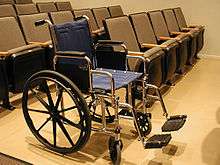
Adapting the built environment to make it more accessible to wheelchair users is one of the key campaigns of disability rights movements and the Americans with Disabilities Act of 1990 (ADA). The most important principle is universal design - that all people regardless of disability are entitled to equal access to all parts of society like public transportation and buildings. A wheelchair user is less disabled in an environment without stairs.
Sometimes it is necessary to add structures like ramps or elevators in order to permit people in wheelchairs (and those using crutches, canes, walkers and so forth, or those with unsupported walking disabilities) to use a particular building. Other important adaptations are powered doors, lowered fixtures such as sinks and water fountains, and toilets with adequate space and grab bars to allow the person to maneuver himself or herself out of the wheelchair onto the fixture. In the United States, most new construction for public use must be built to ADA standards of accessibility.
With the aging of the population, architects are seeking to design wheelchair ramps for private homes that are less obtrusive and harmonize better with the overall design of the home's structure. Other important adaptations to private homes are larger bathroom doors that can accommodate wheelchairs, and showers and bathtubs that are designed for accessibility. These designs can permit the use of mobile shower chairs or transfer benches to facilitate bathing for people with disabilities. Wet rooms are bathrooms where the shower floor space and bathroom floor are one continuous surface. Such floor designs allow a patient in a shower chair to be pushed directly into the shower without needing to overcome a barrier or lip.
The construction of low floor trams and buses is being encouraged, whereas the use of paternosters in public buildings without any alternative method of transportation has been criticized due to the lack of access for wheelchair users. Modern urban architecture now incorporates better accessibility for people with disabilities.
In many countries, such as the UK, the owners of inaccessible buildings are advised to keep a lightweight portable wheelchair or scooter access ramp on hand to make premises disabled-friendly.
Vehicles
Public transit accessible vehicles are public transportation revenue vehicles which do not restrict access, are usable and provide allocated space and/or priority seating for people who use wheelchairs.
In Los Angeles there is a program to remove a small amount of seating on some trains to make more room for bicycles and wheelchairs.[13]
New York City's entire bus system is wheelchair-accessible, and a multimillion-dollar renovation program is underway to provide elevator access to many of the city's 485 subway stations.
In Adelaide, Australia, all public transport has provision for at least two wheelchairs per bus, tram or train. In addition all trains have space available for bicycles.
The Washington, D.C. Metro system features complete accessibility on all its subways and buses.
In Paris, France, the entire bus network, i.e. 60 lines, has been accessible to wheelchair users since 2010.[14]
In the United States a wheelchair that has been designed and tested for use as a seat in motor vehicles is often referred to as a "WC19 Wheelchair" or a "transit wheelchair". ANSI-RESNA WC19 (officially, SECTION 19 ANSI/RESNA WC/VOL. 1 Wheelchairs for use in Motor Vehicles) is a voluntary standard for wheelchairs designed for use when traveling facing forward in a motor vehicle. ISO 7176/19 is an international transit wheelchair standard that specifies similar design and performance requirements as ANSI/RESNA WC19.
Distribution organizations
Several organizations exist that help to give and receive wheelchair equipment. Organizations that accept wheelchair equipment donations typically attempt to identify recipients and match them with the donated equipment they have received. Organizations that accept donations in the form of money for wheelchairs typically have the wheelchairs manufactured and distributed in large numbers, often in developing countries. Organizations focusing on wheelchairs include Direct Relief, the Free Wheelchair Mission, Hope Haven, Personal Energy Transportation, the Wheelchair Foundation and WheelPower.
Smart wheelchairs
A smart wheelchair is any motorized platform with a chair designed to assist a user with a physical disability, where an artificial control system augments or replaces user control.[15] Its purpose is to reduce or eliminate the user's task of driving a motorized wheelchair. Usually, a smart wheelchair is controlled by a computer, has a suite of sensors and applies techniques in mobile robotics, but this is not necessary. The interface may consist of a conventional wheelchair joystick, or it may be a "sip-and-puff" device or a touch-sensitive display connected to a computer. This is different from a conventional motorized or electric wheelchair, in which the user exerts manual control over motor speed and direction via a joystick or other switch- or potentiometer-based device, without intervention by the wheelchair's control system.
Smart wheelchairs are designed for a variety of user types. Some platforms are designed for users with cognitive impairments, such as dementia, where these typically apply collision-avoidance techniques to ensure that users do not accidentally select a drive command that results in a collision. Other platforms focus on users living with severe motor disabilities, such as cerebral palsy, or with quadriplegia, and the role of the smart wheelchair is to interpret small muscular activations as high-level commands and execute them. Such platforms typically employ techniques from artificial intelligence, such as path-planning.
Seating systems
Wheelchair seating systems are designed for wheelchair users to redistribute pressure from areas of the body that are at risk of pressure ulcers.[16] For someone in the sitting position, the parts of the body that are the most at risk for tissue breakdown include the ischial tuberosities, coccyx, sacrum and greater trochanters. Wheelchair cushions are also used to provide stability, comfort, aid posture and absorb shock.[17]
Prior to 1970, little was known about the effectiveness of wheelchair cushions and there was not a clinical method of evaluating wheelchair seat cushions. Most recently, pressure imaging (or pressure mapping) is used to help determine each individual’s pressure distribution to properly determine and fit a seating system.[18][19][20]
Cushions are prescribed by a patient’s rehabilitation or medical teams. Seating effectiveness is determined by immersion, envelopment and interface pressures.
See also
- Mobility scooter
- Motorized wheelchair
- Wheelchair ramp
- Wheelchair DanceSport
- Wheelmap.org, web mapping project (collects information worldwide about wheelchair accessibility of places)
Notable wheelchair manufacturers
References
- ↑ Joseph Flaherty (24 May 2012). "Putting the ‘Whee!’ Back in ‘Wheelchair’". Wired. Retrieved 25 May 2012.
- 1 2 Maggie Koerth-Baker. "Who Invented the Wheelchair?". Mental Floss Inc. Retrieved 25 May 2012.
- ↑ "A History of the World – Object : Bath Chair". BBC. 2012-09-02. Retrieved 2012-11-19.
- ↑ Johnson, Nelson (2012-02-01). Boardwalk Empire: The Birth, High Times, and Corruption of Atlantic City (Kindle ed.). Independent Publishers Group. p. 28.
- ↑ Everest, Herbert A., Jennings, Harry C., "Folding wheel chair", US Patent 2095411, 1937
- ↑ FIPFA Official Website
- ↑ Langbein, W Edwin; Fehr, Linda (1993). "Research Device to Preproduction Prototype: A Chronology" (PDF). JRRD 30 (4): 436–442. ISSN 0748-7711.
- ↑ O'Connor, Thomas; Fitzgerald, Shirley G; Cooper, Rory A; Thorman, Tricia A; Boninger, Michael L (2002). "Kinetic and physiological analysis of the GameWheels system". JRRD 39 (6): 627–634. ISSN 0748-7711.
- ↑ "British made 'Carbon Black' a wheelchair revolution | News | Medilink, Yorkshire and Humber – British made 'Carbon Black' a wheelchair revolution". Medilink.co.uk. 2011-10-17. Retrieved 2012-11-19.
- ↑ "London launch for Nairn firm's Carbon Black wheelchair". BBC News. 14 October 2011.
- ↑ EPFL CNBI project
- ↑ EPFL CNBI project
- ↑ Newton, Damien. "Metro Making Room for Bikes on Their Trains | Streetsblog Los Angeles". La.streetsblog.org. Retrieved 2012-11-19.
- ↑ "Network of accessible Parisian buses; Paris: Public transport and accessibility". PARISINFO.COM
The official website of the Paris Convention and Visitors Bureau. Retrieved 2013-05-27. line feed character in
|publisher=at position 14 (help) - ↑ Richard C. Simpson, (2005) "Smart Wheelchairs: A Literature Review" J. Rehabilitation Res. & Dev. 42 (4), pp. 423-438.
- ↑ Garber, S.L. (1985) Wheelchair Cushions: A Historical Review. The American Journal of Occupational Therapy 39.7. pp.453-59.
- ↑ Ferguson-Pell, M. (1992) Choosing a Wheelchair System. Journal of Rehabilitation Research and Development. p.49.
- ↑ Eakin, P.A. Porter-Armstrong, A.P. & Stinson, M.D. (2003) Pressure mapping systems: reliability of pressure map interpretation. Clinical Rehabilitation 17: pp.504-511.
- ↑ Ferguson-Pell, M., Cardi, M. D. Prototype Development and Comparative Evaluation of Wheelchair Pressure Mapping System. Assistive Technology. Vol. 5, No. 2. pp.78-91
- ↑ Hanson, D., Langemo, D., Anderson, J., Thompson, P., Hunter, S. (2009) Can pressure mapping prevent ulcers? Nursing. Vol. 39. Issue 6. pp.50-51.
External links
 The dictionary definition of wheelchair at Wiktionary
The dictionary definition of wheelchair at Wiktionary Media related to Wheelchairs at Wikimedia Commons
Media related to Wheelchairs at Wikimedia Commons
| ||||||||||||||||||||||||||
| ||||||||||||||||||||||||||||||||||||||||||||||||||||||||||||
| ||||||||||||||||||||||||||||||||||||||||||||||||||||
|